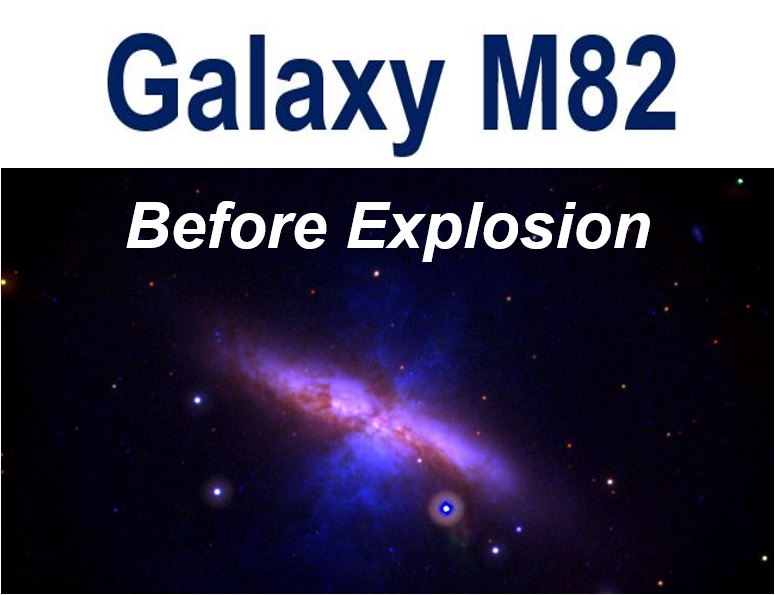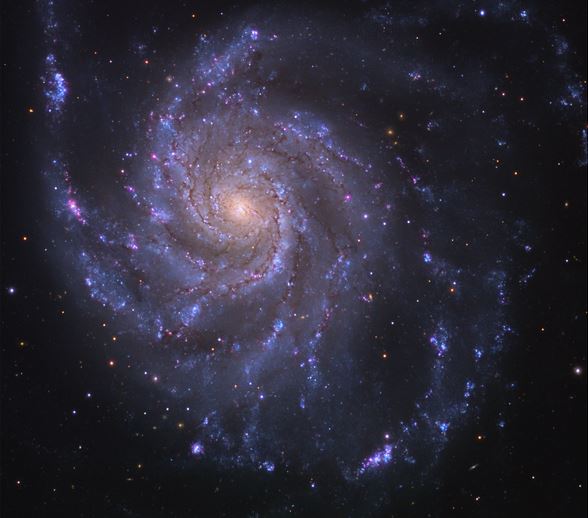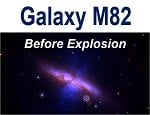The findings of two recent studies indicate that the acceleration of our Universe’s expansion since the Big Bang may not be as fast as previously thought. Astrophysicists in one of the latest studies say exploding stars (supernovae) are more diverse than according to current estimates.
A University of Arizona-led team, who published details of their study in the Astrophysical Journal (citation below), says their findings have implications for major cosmological questions, including how rapidly the Universe has been expanding ever since it was born.
Team leader, Peter A. Milne, and colleagues discovered that a type of Ia supernovae, which the science community has considered as so uniform they have used them as cosmic ‘beacons’ to measure the depths of the Universe, actually fall into varying populations.

This Swift UVOT image shows galaxy M82 before the explosion and combines data acquired between 2007 and 2013. (Credit: NASA/Swift/P. Brown, TAMU)
The scientists explain that their finding is similar to sampling a selection of 100-watt light bulbs in a hardware shop and discovering that they do not all have the same brightness.
Milne, an associate astronomer with the UA’s Department of Astronomy and Steward Observatory, said:
“We found that the differences are not random, but lead to separating Ia supernovae into two groups, where the group that is in the minority near us are in the majority at large distances – and thus when the universe was younger. There are different populations out there, and they have not been recognized.”
“The big assumption has been that as you go from near to far, type Ia supernovae are the same. That doesn’t appear to be the case.”
Finding challenges current Universe expansion explanation
Their discovery challenges the currently accepted view that the Universe is expanding at an accelerating rate, pulled apart by dark energy, a poorly-understood force.
This view is based on observations made by three scientists who went on to win the 2011 Nobel Prize for Physics.
The three scientists had discovered independently that several supernovae had appeared fainter than predicted because they had moved further away from us than they should have done if the Universe expanded at a constant rate.

An optical image of galaxy M101 obtained by Adam Block with the UA’s Mt. Lemmon Sky Center. (Image: University of Arizona)
This indicated that stars and galaxies were moving away from each other at an increasing speed, i.e. something has been pushing the Universe apart at an accelerating rate.
Milne explained:
“The idea behind this reasoning, is that type Ia supernovae happen to be the same brightness – they all end up pretty similar when they explode. Once people knew why, they started using them as mileposts for the far side of the universe.”
“The faraway supernovae should be like the ones nearby because they look like them, but because they’re fainter than expected, it led people to conclude they’re farther away than expected, and this in turn has led to the conclusion that the universe is expanding faster than it did in the past.”
Ultraviolet light observations provided more comprehensive data
The authors observed a large sample of type Ia supernovae in visible and ultraviolet light, from the NASA’s Swift satellite and the Hubble Space Telescope.
The data gathered with Swift were vital because the difference between the populations – marginal shifts toward the red or the blue spectrum – are subtle in visible light, which had been used previously to detect type Ia supernovae, but became evident only through Swift’s dedicated follow-up observations using ultraviolet.
Co-author of the first paper, Niel Gehrels, principal investigator of the Swift satellite, said:
“These are great results. I am delighted that Swift has provided such important observations, which have been made toward a science goal that is completely independent of the primary mission. It demonstrates the flexibility of our satellite to respond to new phenomena swiftly.”
Milne said:
“The realization that there were two groups of type Ia supernovae started with Swift data. Then we went through other datasets to see if we see the same. And we found the trend to be present in all the other datasets.”
“As you’re going back in time, we see a change in the supernovae population. The explosion has something different about it, something that doesn’t jump out at you when you look at it in optical light, but we see it in the ultraviolet.”
“Since nobody realized that before, all these supernovae were thrown in the same barrel. But if you were to look at 10 of them nearby, those 10 are going to be redder on average than a sample of 10 faraway supernovae.”
The scientists concluded that some of the reported acceleration of the Universe could be explained by color differences between the two groups of supernovae, leaving an acceleration rate slower than initially reported.
For this, less dark energy would be required than currently assumed.
Milne said:
“We’re proposing that our data suggest there might be less dark energy than textbook knowledge, but we can’t put a number on it. Until our paper, the two populations of supernovae were treated as the same population. To get that final answer, you need to do all that work again, separately for the red and for the blue population.”
Before scientists can fully understand the impact on current measures of dark energy, they will need to gather more data, the authors pointed out.
Citation: “The Changing Fractions of Type IA Supernova NUV–Optical Subclasses With Redshift,” Peter A. Milne, Ryan J. Foley, Peter J. Brown and Gautham Narayan. The Astrophysical Journal. Publsihed April 2015. DOI: 10.1088/0004-637X/803/1/20.

